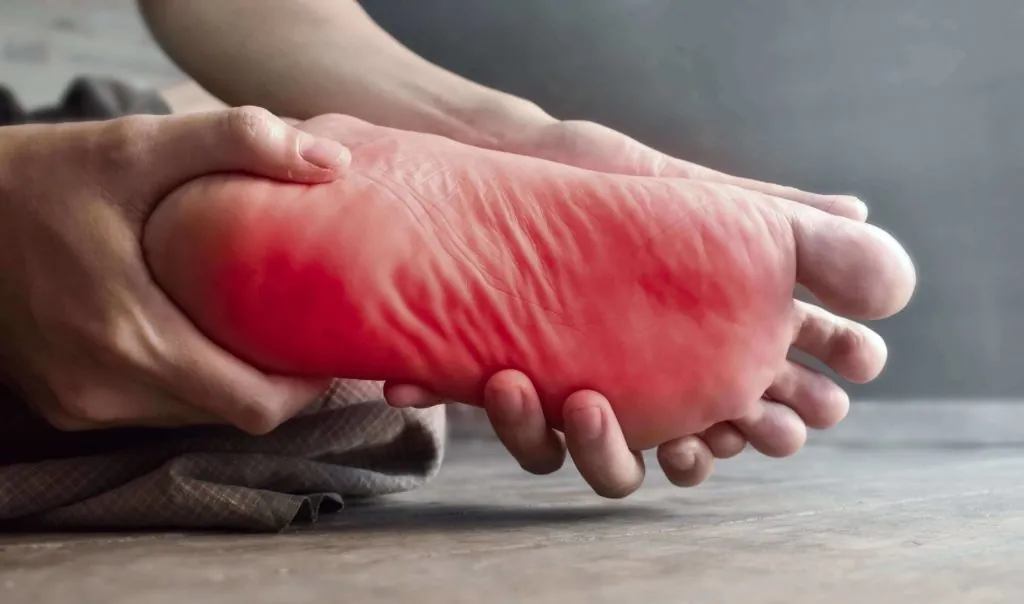
Plantar fasciitis is a common condition caused by inflammation of the band of tissue (plantar fascia) that runs across the bottom of the foot, connecting the heel bone to the toes. Experts estimate two to three million people in the U.S. experience foot and heel pain associated with plantar fasciitis each year, with about one million people a year seeking treatment.
Doctors routinely recommend physical therapy to manage and overcome the pain associated with plantar fasciitis and to regain walking ability. Many studies support the effectiveness of physical therapy for the treatment of plantar fasciitis. In fact, a study on plantar fasciitis published in the Journal of Orthopedic and Sports Physical Therapy found a “faster recovery time for those who receive evidence-based physical therapy for their foot pain.”
What Causes Plantar Fasciitis?
The plantar fascia supports the arch of your foot and acts as a shock absorber when you walk, run, jump, or otherwise put stress on your heel and the attached tissue. Repeated stress can irritate, inflame, or tear the plantar fascia, causing pain and difficulty walking.
Although plantar fasciitis is a common injury among athletes, it can affect non-athletes and people of any age. It is especially common for those engaging in a sport, job, or activity that involves prolonged running, standing, or walking on hard surfaces. If you are overweight, flat-footed, have a high foot arch, or wear shoes without adequate foot support, you are also at increased risk for plantar fasciitis.
Plantar fasciitis can result from dysfunction in another area of the body. For example, an injury to the hip or leg muscles can affect gait, which may cause stress to the plantar fascia.
Symptoms of Plantar Fasciitis
If you often experience one or more of the following symptoms, you may have plantar fasciitis.
- Stabbing pain on the bottom of the foot. You will likely feel the strongest pain with your first few steps after getting up in the morning, after sitting or standing for a long period, when climbing stairs, or after exercise.
- Burning or aching on the bottom of the foot.
- Tightness and tenderness along the arch of the foot.
You may experience pain after, rather than during, the activity, although some people experience severe throbbing pain in the heel as they are walking, running, or otherwise placing stress on the heel.
Physical Therapy Treatment for Plantar Fasciitis
Doctors typically refer patients to physical therapy for the treatment of plantar fasciitis. However, you may also contact MOTION or another physical therapy clinic directly to request an evaluation.
Our MOTION physical therapists are experts at treating pain and movement disorders. We understand the frustration of living with a painful, limiting condition and pledge “to get you back to what moves you” quickly and safely. Our goal is to help you regain your mobility so you can get back to enjoying an active lifestyle.
In order to design the most effective program to treat your foot pain, we will perform a complete physical examination. This may include palpitation of the heel, arch of the foot, and toes, and gentle stretching of the ankle.
We will also conduct some or all the following steps during your initial visit:
- A thorough review of your medical history
- A pain assessment, including what makes it better or worse
- Strength and range of motion assessment
- Gait assessment
- Posture evaluation
- Functional movement assessment
During your visit, we will explain how certain activities or health conditions can increase the risk of plantar fasciitis, including the chance for reoccurrence, and suggest modifications that may help you avoid future injury.
The goal of your physical therapy rehab program will be to:
- Decrease inflammation and pain
- Increase blood flow
- Increase the range of motion of your ankle and plantar fascia
- Strengthen the plantar fascia and surrounding muscle tissue
- Provide gait and balance training
To help you achieve your physical therapy goals, we will work with you on exercises to flex and stretch plantar fascia and calf muscles, strengthen muscles around your ankle and foot to improve stability, and tighten core muscles to achieve proper gait.
Your MOTION physical therapist will provide you with a home program designed specifically for your needs and goals and will also work with you on lifestyle changes to help you stay healthy and thrive long-term. This may include footwear recommendations, use of orthotic inserts or heel cups, nutrition counseling, weight management approaches, low-impact activity options, use of athletic tape or night splints, and more.
The more faithfully you attend PT sessions and perform home exercises, the more quickly you may be able to return to a higher degree of mobility and comfort.
Besides manual therapeutic techniques, your MOTION physical therapist may incorporate other modalities into your treatment plan. These may include:
- Ice packs to reduce inflammation and pain
- Ultrasound to break down damaged tissue
- Electrical stimulation to block pain signals and improve blood flow
- Active release technique (ART®) to break up scar tissue, improve blood flow, and speed healing
- Kinesiotaping to support the damaged ligament, improve blood flow, and decrease swelling
- Dry needling to reduce tightness in muscles that may cause pain and gait problems*
- Dry cupping to improve blood circulation and loosen muscles and ligaments
- Iontophoresis to receive medication through the skin
How Long Does It Take to Heal from Plantar Fasciitis?
The time it takes to heal from plantar fasciitis varies for each individual. Several factors may impact the timeline, including age, overall fitness, severity of the condition, coexisting medical conditions or injuries, and obesity.
If you are consistent in your in-clinic physical therapy and home exercise program and use night splints, orthotics, or other PT recommended devices, you should see improvement within a few weeks or months. It can take six to nine months, or longer, to fully recover.
Why Consider MOTION PT for Plantar Fasciitis Rehabilitation?
Since 2015, MOTION has provided transformative physical and occupational therapy services to clients of all ages. We promise to treat you with the respect you deserve, and always invite your input as we work together to accomplish your recovery goals.
MOTION physical therapists are movement experts, with years of experience helping people reduce or manage pain, regain function, improve balance and flexibility, and prevent future injuries or disabilities.
Our mission is to help you regain the highest functional mobility possible, so you can resume a happier, more active life.
The more closely we work together, the more quickly you may be able to achieve your desired results. To ensure you have sufficient time with your physical therapist, sessions at MOTION are 40 minutes rather than the industry standard 30-minute sessions.
We will teach you how to take what you learn at your physical therapy sessions home, so you can continue to strengthen your body and improve your quality of life. If you are diligent in practicing your home exercise program even after you complete your in-clinic program, you are more likely to enjoy long-term recovery and a lower risk of recurrence.
Stay on track after your initial plan of care by enrolling in a Wellness@MOTION program*, including annual wellness checkups, certified yoga, custom orthotics, ergonomic assessments, strength and conditioning, and golf performance (TPI).
In response to the needs of so many who are struggling to regain their health and vitality after suffering from COVID-19, we are proud to announce our Post-Acute COVID Recovery Program. If you or a loved one is still experiencing symptoms weeks or months after the initial infection, we can help.
Contact us today to schedule an in-clinic or telehealth appointment.
* available in select MOTION locations
